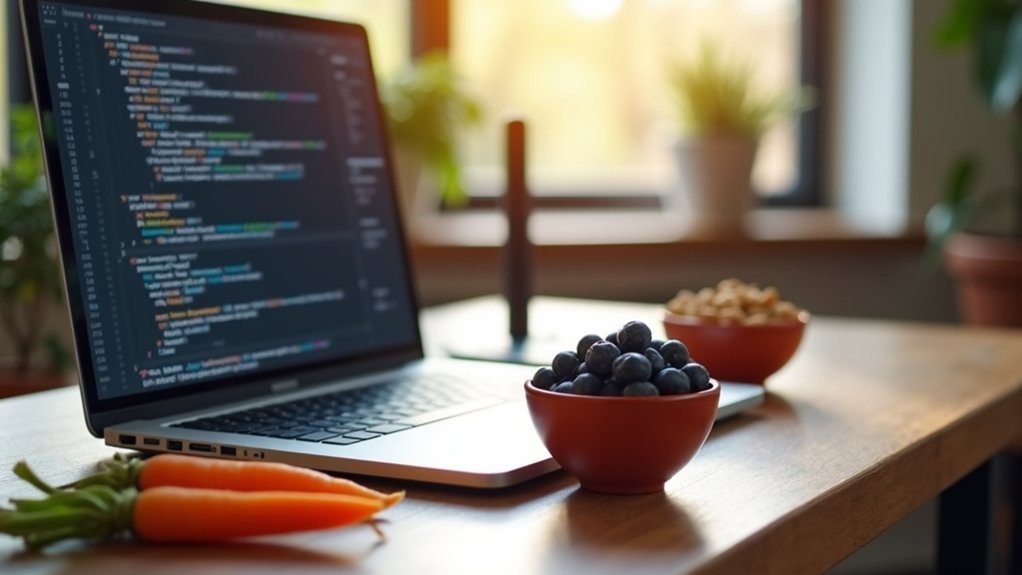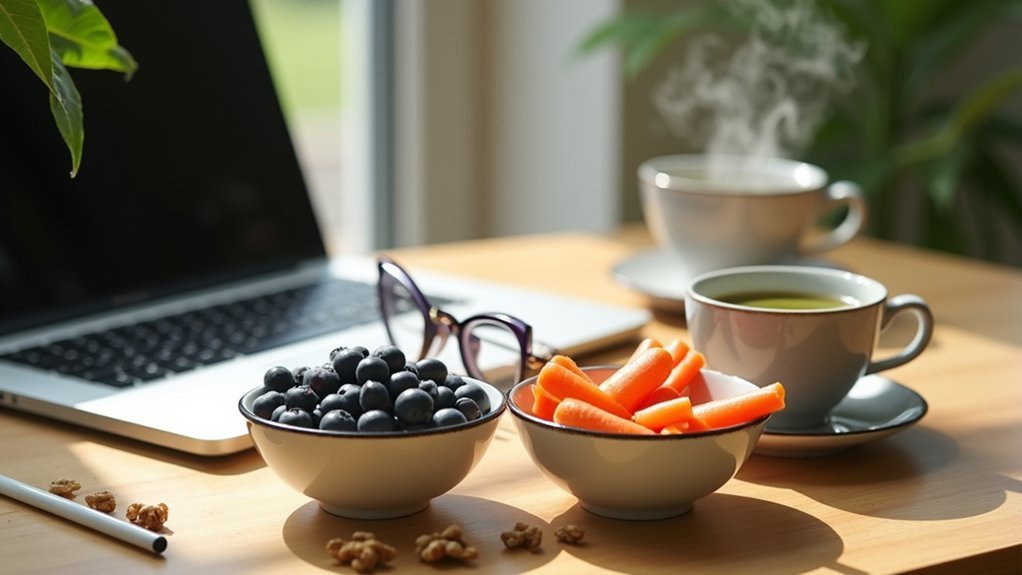As a programmer, you’re constantly battling digital eye strain from hours of screen time. Your eyes endure significant stress, processing complex code and maintaining laser-sharp focus. While traditional solutions like screen breaks help, your nutrition plays a critical role in ocular health. What if strategic snacking could actively combat eye fatigue and support your visual performance? Understanding how specific superfoods can mitigate screen-induced stress might revolutionize your professional well-being and cognitive resilience.
Key Takeaways
- Dark chocolate improves blood circulation in ocular tissues and provides antioxidants that help reduce visual stress during extended coding sessions.
- Trail mix with walnuts and almonds delivers vitamin E and omega-3 fatty acids, which combat inflammation and support retinal health.
- Blueberries offer powerful antioxidants that neutralize oxidative damage caused by prolonged screen exposure and blue light emissions.
- Leafy green smoothies containing spinach or kale provide lutein and zeaxanthin, natural compounds that filter harmful blue light and protect vision.
- Salmon bites or jerky supply essential omega-3 fatty acids that enhance eye moisture, reduce dry eye syndrome, and support overall visual performance.
Understanding Digital Eye Strain in Programming

While digital devices have become an integral part of a programmer’s daily workflow, they also introduce significant challenges to eye health and visual comfort. Digital eye strain emerges from prolonged screen exposure, manifesting through decreased blinking rates and increased visual fatigue. You’re likely experiencing this syndrome if you notice persistent eye dryness, irritation, or reduced focus during extended coding sessions.
Research indicates that screen time can dramatically reduce your natural blinking frequency by up to 50%, causing eye discomfort and potential long-term visual stress. Blue light emissions further compound these challenges by disrupting sleep patterns and inhibiting melatonin production. Understanding these physiological responses empowers you to implement proactive strategies, such as the 20-20-20 rule, to mitigate digital eye strain’s progressive impact on your professional performance and ocular health.
Nutritional Foundations for Healthy Vision

Because programmers spend countless hours staring at digital screens, understanding nutritional strategies for eye health becomes paramount to maintaining ideal visual performance. Targeted nutrient intake can greatly mitigate digital eye strain through strategic consumption of key vision-supporting compounds.
Vitamin A facilitates moisture retention and night vision clarity, while lutein and zeaxanthin act as critical blue light filters, reducing retinal stress. Omega-3 fatty acids provide essential hydration and comfort mechanisms for eyes experiencing prolonged screen exposure. These nutrients work synergistically to protect visual systems from oxidative damage and functional degradation.
Strategic dietary choices involving leafy greens, fatty fish, and nutrient-dense foods can proactively support eye health, enabling programmers to maintain optimal visual performance and minimize screen-related physiological challenges.
Essential Nutrients for Eye Protection

Building upon the foundational understanding of visual health for screen-intensive professionals, targeted nutrient intake emerges as a powerful strategy for eye protection.
Key nutrients can help you maintain healthy eyes and reduce your risk of digital eye strain:
- Omega-3 fatty acids protect retinal function, mitigating dry eye syndrome through regular consumption of fatty fish like salmon.
- Vitamin C helps neutralize oxidative stress from blue light exposure, with citrus fruits and nuts providing potent antioxidant defense mechanisms.
- Lutein and zeaxanthin in leafy greens filter harmful light wavelengths, specifically protecting the macula’s central vision capabilities.
Supplementing your diet with zinc-rich foods like oysters and lean meats further enhances eye protection by facilitating vitamin A transportation and preventing light-induced retinal damage. Consistent hydration complements these nutritional strategies, ensuring ideal eye moisture and reducing screen-related discomfort.
Top Superfoods to Combat Screen Fatigue

As screen time increasingly dominates modern professional landscapes, programmers can strategically leverage nutrient-dense superfoods to mitigate digital eye strain and cognitive fatigue. Leafy greens like spinach and kale emerge as powerful defenders, containing lutein and zeaxanthin that filter harmful blue light emitted by digital screens. Dark chocolate offers an additional protective mechanism, with its flavonoids improving ocular blood circulation and potentially reducing visual stress.
Complementing these choices, blueberries provide potent antioxidants that counteract oxidative damage, while nuts and seeds deliver essential vitamin E and omega-3 fatty acids to combat inflammation. Carrots, packed with beta-carotene, further support thorough eye health. By integrating these targeted nutritional strategies, programmers can proactively defend against screen-induced visual exhaustion and maintain peak cognitive performance.
Strategic Snacking for Eye Health

When programmers strategically select nutrient-dense snacks, they can proactively shield their visual health during extended screen sessions. By incorporating targeted nutrition, developers can mitigate eye strain through scientifically supported dietary choices:
- Prioritize omega-3 fatty acids from walnuts and salmon to reduce inflammation and enhance blood vessel resilience in ocular tissues.
- Consume vitamin E-rich almonds and sunflower seeds to combat oxidative stress and prevent eye fatigue during prolonged computer use.
- Integrate leafy green vegetables like spinach and kale, which contain lutein and zeaxanthin, critical antioxidants that protect against harmful blue light exposure.
These intentional snacking strategies offer programmers a pragmatic approach to maintaining visual wellness, transforming nutrition into a preventative mechanism for mitigating screen-related ocular stress.
Hydration and Vision Performance
Because ideal visual performance hinges on precise physiological mechanisms, programmers must recognize hydration’s critical role in maintaining ocular health during extended screen sessions. Water intake directly influences tear production, reducing eye strain and preventing dry eyes.
| Hydration Source | Antioxidant Level | Eye Health Impact |
|---|---|---|
| Water | Low | Moderate |
| Herbal Tea | High | Significant |
| Cucumber | Medium | Moderate |
| Watermelon | High | Substantial |
Your visual system demands consistent fluid intake to sustain peak performance. Consuming water-rich foods and beverages supports tear film stability, mitigates visual fatigue, and enhances focus during prolonged coding sessions. By prioritizing strategic hydration, you’ll protect your eyes from potential screen-induced stress and maintain peak cognitive and visual function throughout demanding programming tasks.
Omega-3 Rich Foods for Retinal Support
The retinal guardian: omega-3 fatty acids emerge as a critical nutritional strategy for programmers seeking optimal visual performance and long-term eye health. These essential nutrients provide robust support for ocular function through multiple mechanisms:
- Blood Flow Enhancement: Omega-3s improve microcirculation to retinal tissues, delivering critical oxygen and nutrients necessary for peak visual function.
- Inflammation Reduction: By mitigating inflammatory processes, these fatty acids help protect sensitive eye structures from potential damage during prolonged screen exposure.
- Dry Eye Mitigation: Regular consumption can alleviate dry eye syndrome symptoms common among tech professionals experiencing extended screen time.
Whether sourced from fatty fish like salmon or plant-based alternatives such as walnuts and chia seeds, omega-3 fatty acids represent a targeted nutritional intervention for maintaining robust eye health and reducing long-term visual strain risks.
Antioxidant-Packed Snack Alternatives
Programmers seeking cognitive resilience and ocular protection can strategically leverage antioxidant-rich snack alternatives to mitigate the physiological stress induced by prolonged digital engagement. By incorporating targeted foods, you’ll combat oxidative damage and support eye health effectively.
| Snack | Antioxidants | Eye Health Benefits |
|---|---|---|
| Blueberries | High flavonoids | Reduces eye strain |
| Almonds | Vitamin E | Cellular protection |
| Red Peppers | Vitamin C | Supports blood vessels |
| Dark Chocolate | Flavonoids | Improves blood flow |
| Strawberries | Polyphenols | Neutralizes free radicals |
These scientifically validated snack options provide essential nutrients that directly target oxidative stress. By strategically consuming antioxidant-rich foods, you’ll enhance ocular resilience, mitigate screen-induced fatigue, and optimize your cognitive performance through targeted nutritional interventions.
Meal Planning for Long-Term Eye Wellness
Strategic meal preparation emerges as a powerful methodology for sustained visual performance and neurological enhancement among professionals immersed in digital environments. By prioritizing eye health through a targeted nutritional approach, programmers can effectively reduce eye strain and maintain peak visual function.
Consider integrating these key nutritional strategies:
- Incorporate omega-3 rich foods like salmon and walnuts to combat inflammation and enhance eye hydration during extended screen time.
- Consume leafy greens abundant in lutein and zeaxanthin to provide natural blue light protection for ocular tissues.
- Select colorful produce high in beta-carotene and vitamin C to support thorough eye wellness and cellular repair mechanisms.
A healthy diet focused on targeted nutrient intake represents a scientifically-validated approach to mitigating the physiological challenges associated with prolonged digital engagement.
Frequently Asked Questions
What Snacks Are Good for Your Eyes?
You’ll boost eye health with vision-boosting foods like walnuts, carrots, kale, red peppers, and almonds. These eye-friendly snacks provide antioxidants, vitamins, and nutrients that protect your vision from screen-related strain and potential long-term damage.
What Super Foods Are Good for Your Eyesight?
You’ll be amazed how certain foods protect your vision: carrots boost eye health, leafy greens filter harmful light, and omega-3s support retinal function. These scientifically-proven superfoods can dramatically enhance your eyesight’s resilience and clarity.
What to Eat to Reduce Eye Number?
You’ll combat blue light’s impact on digital fatigue by consuming lutein-rich foods like spinach and kale, which enhance vision health. Zinc-packed sources such as pumpkin seeds and lean proteins further support your eyes’ protective mechanisms against screen-induced strain.
What Is the Miracle Food for Eyes?
Dark leafy greens and carrots are your miracle eye foods, packed with lutein and beta-carotene. Blueberries’ potent antioxidants protect retinal cells, reducing oxidative stress and potentially mitigating age-related macular degeneration’s progression through scientifically validated nutritional interventions.
How Do You Reduce Eye Strain?
You’ll blink, breathe, and break from screens—strategically. Implement blue light filters, perform targeted eye exercises, and schedule periodic digital detox moments to scientifically mitigate visual fatigue and maintain ideal ocular health during prolonged computational tasks.
Conclusion
You’re the guardian of your vision, a digital sentinel protecting your most valuable professional asset. Just as code transforms complexity into elegance, strategic superfood choices can transform screen strain into sustained clarity. Your eyes are precision instruments—nourish them deliberately. With each nutrient-rich bite, you’re not just eating; you’re calibrating your body’s most critical performance interface.



